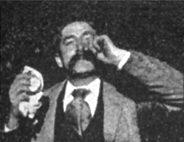Smokeless tobacco



Smokeless tobacco is tobacco or a tobacco product that is used by means other than smoking. These uses include chewing, sniffing, placing the product between the teeth and gum, or application to the skin. Smokeless tobacco products are produced in various forms, such as chewing tobacco, snuff, snus, and dissolvable tobacco products.[1] It is highly addictive.[2]
It is correlated with a number of adverse effects such as dental disease, oral cancer, oesophagus cancer, and pancreas cancer, as well as adverse reproductive effects including stillbirth, premature birth and low birth weight.[2]
Types
Types of smokeless tobacco include:
- Dipping tobacco, a type of tobacco that is placed between the lower or upper lip and gums
- Chewing tobacco, a type of tobacco that is chewed
- Iqmik, an Alaskan tobacco product which also contains punk ash
- Snuff, a type of tobacco that is inhaled or "snuffed" into the nasal cavity
- Snus, similar to dipping tobacco although the tobacco is placed under the upper lip and there is no need for spitting
- Creamy snuff, a fluid tobacco mixture marketed as a dental hygiene aid, albeit used for recreation
- Naswar, an Afghan tobacco product similar to dipping tobacco
- Tobacco gum, a kind of chewing gum containing tobacco
- Gutka, a mixture of tobacco, areca nut, and various flavoring sold in South Asia
- Dissolvable tobacco, a variation on chewing tobacco that completely dissolves in the mouth
- Toombak and shammah, preparations found in North Africa, East Africa, and the Arabian peninsula
- Topical tobacco paste, a paste applied to the skin and absorbed through the dermis
Prevalence
More than 300 million people are using smokeless tobacco worldwide.[2]
Safety
Smokeless tobacco products vary extensively worldwide in both form and health hazards, with some evidently toxic forms such as from South Asia, and some forms with less hazards such as snus from Sweden.[3] It is correlated with a number of adverse effects such as dental disease, oral cancer, oesophagus cancer, and pancreas cancer, as well as adverse reproductive effects including stillbirth, premature birth and low birth weight.[2] A correlation was identified between smokeless tobacco and risk of fatal coronary artery disease and fatal stroke.[2] Use of smokeless tobacco also seems to greatly raise the risk of non-fatal ischaemic heart disease among users in Asia, although not in Europe.[2]
See also
- Herbal smokeless tobacco
- Tobacco
- Electronic cigarette, a cigarette-shaped product that vaporizes nicotine
- Herbal cigarette
- Tobacco usage in sport
References
| Wikimedia Commons has media related to Snuff (tobacco). |
| Wikimedia Commons has media related to Chewing tobacco. |
- ↑ Czoli, Christine D; Fong, Geoffrey T; Mays, Darren; Hammond, David (2016). "How do consumers perceive differences in risk across nicotine products? A review of relative risk perceptions across smokeless tobacco, e-cigarettes, nicotine replacement therapy and combustible cigarettes". Tobacco Control: tobaccocontrol–2016–053060. doi:10.1136/tobaccocontrol-2016-053060. ISSN 0964-4563. PMID 27625408.
- 1 2 3 4 5 6 Vidyasagaran, A. L.; Siddiqi, K.; Kanaan, M. (2016). "Use of smokeless tobacco and risk of cardiovascular disease: A systematic review and meta-analysis". European Journal of Preventive Cardiology. doi:10.1177/2047487316654026. ISSN 2047-4873. PMID 27256827.
- ↑ O'Connor, RJ (March 2012). "Non-cigarette tobacco products: what have we learnt and where are we headed?". Tobacco control. 21 (2): 181–90. doi:10.1136/tobaccocontrol-2011-050281. PMC 3716250
 . PMID 22345243.
. PMID 22345243.